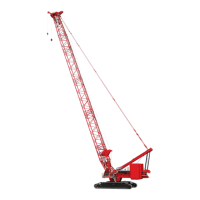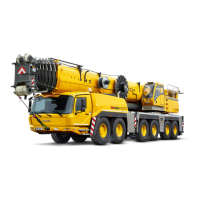Manitowoc Published 09-09-16, Control # 229-09 10-9
MLC650 SERVICE/MAINTENANCE MANUAL ACCESSORIES
Setup Remote Control
Setup Remote Overview
NOTE: The setup remote is covered in Section 4 of the
Operator Manual.
The setup remote control communicates with the CCM-10
control module using the controller area network bus (CAN
Bus). The crane control modules use the CAN Bus to
communicate with each other.
Neutral Position Using Setup Remote
See Figure 10-9 for the following.
When the setup remote is not sending a command, the
rotating bed jack cylinder valve spools, located in the
upperworks jacking and rigging winch valve assembly (1),
are held in the neutral position by the return springs.
Hydraulic fluid from the accessory pump is prevented from
flowing to the counterbalance valve (2).
When in neutral, the counterbalance valve provides a load-
holding function. The sequence valves within the
counterbalance valve are closed, stopping the flow to and
from the cylinders. The jack cylinders are held in position by
trapped hydraulic fluid.
Extend Jack Cylinder Using Setup Remote
See Figure 10-10 for the following.
NOTE: The following describes the operation to extend
one rotating bed jack cylinder. The operation is the
same for all rotating bed jack cylinders.
When a raise command is received from the setup remote,
the CCM-10 control module or IOLC31 control module
(depending on the jack being controlled) energizes the
corresponding rotating bed jack extend solenoid. The extend
solenoid valve routes pilot hydraulic fluid to the
corresponding valve spool. This causes the valve spool to
shift to a position that allows hydraulic fluid from the
accessory pump to flow to the corresponding jack cylinder
counterbalance valves (2).
Within the counterbalance valves, flow and control is as
follows:
• The rod side counterbalance valve is piloted open by the
rod side pressure and the accessory pressure from the
valve spool on the extend side. Once open, the oil on the
rod side is allowed to exit the cylinder and return to tank.
• The piston side counterbalance valve has an integral
bypass check valve that allows the accessory pressure
to enter the piston side of the cylinder, extending the
cylinder.
Retract Jack Cylinder Using Setup Remote
See Figure 10-10 for the following.
NOTE: The following describes the operation to retract one
rotating bed jack cylinder. The operation is the
same for all rotating bed jack cylinders.
When a lower command is received from the setup remote,
the CCM-10 control module or IOLC31 control module
(depending on the jack being controlled) energizes the
corresponding rotating bed jack retract solenoid. The retract
solenoid valve routes pilot hydraulic fluid to the
corresponding valve spool. This causes the valve spool to
shift to a position that allows hydraulic fluid from the
accessory pump to flow to the corresponding jack cylinder
counterbalance valve (2).
Within the counterbalance valves, flow and control is as
follows:
• The piston side counterbalance valve is piloted open by
the piston side pressure and the accessory pressure
from the valve spool on the retract side. Once open, the
oil on the piston side is allowed to exit the cylinder and
return to tank.
• The rod side counterbalance valve has an integral
bypass check valve that allows the accessory pressure
to enter the rod of the cylinder, retracting the cylinder.

